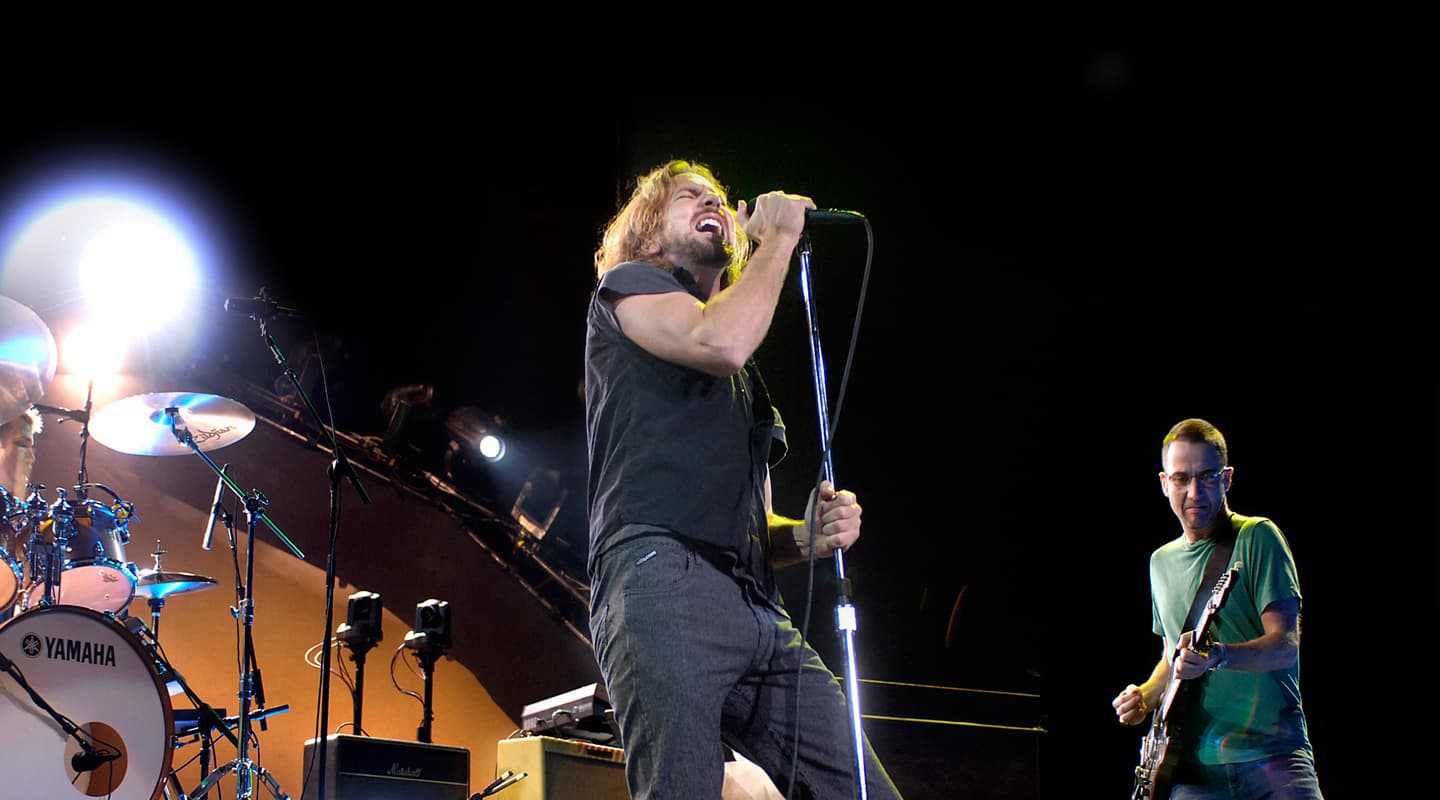
Live On Ten Legs: Brett Eliason & Pearl Jam
Some people complain that studio albums take time, but Pearl Jam’s live CD was eight years in the making! Imagine going through that many years of takes!

Text: Paul Tingen
Photo: Marty Philbey
“Face the fact, some things never come together… parallel lines running on forever…” sang Todd Rundgren in his classic 1989 song Parallel Lines. I dare say he had other things on his mind besides audio engineering when he wrote those lyrics, but the analogy seems a perfect fit when describing the disparate worlds of live and studio engineering.
There’s always been a strange chasm between these two audio camps for some reason. Is it because one side somehow feels threatened by the other? Or is there just an outright lack of respect between the two camps? This often not-so-friendly rivalry seems odd when you think about it: each group uses similar technology and techniques and, of course, has the same aim: to present a cohesive audio image of a musical event. Beyond these similarities, however, studio and live audio engineering are worlds apart.
But not always. Engineer/mixer/producer Brett Eliason is one of the very few who has successfully, and over a longer period of time, managed to straddle this chasm. On his management company’s website (BK Entertainment Group), he’s billed as specialising in “Live mixing, recording, and 5.1 mixing,” and hailed as “one of the pioneers in live recording and mixing.”
Eliason’s credits certainly are of the highest pedigree, and include live recording/mixing work for the likes of Pearl Jam, R.E.M., My Chemical Romance, Avenged Sevenfold, and System of a Down. In the studio, Eliason has worked with Pearl Jam, Neil Young, Dave Matthews, Ian Moore, Madseason, Jewel, and many others.
Eliason has experienced both sides of the divide, and recalls; “when I began doing live stuff, I heard a lot of whispering along the lines of: ‘what does this studio guy know?’ and as I became more known for doing live stuff, when I returned to the studio, people would say, ‘what does this live guy know?’ People do have very exclusive viewpoints!”
So why are the live and studio worlds perceived as such disparate universes? Eliason explains: “It’s true that it takes a long time to learn both, and I’d probably already spent eight years in a recording studio before I started doing front of house. The PA during that initial tour with Pearl Jam – who were supporting the Red Hot Chili Peppers – was provided by Rat Sound, and I spent quite a lot of time looking over owner Dave Levine’s shoulder, picking his brain about how a PA works and disperses in a room. As FOH engineer of the headlining act you’re responsible for the PA, which might consist of 150 boxes to cover everybody in the room as evenly, cleanly and clearly as possible. The point being: it’s not a perfect science, but modern tools make it easier and easier. In the studio, on the other hand, you have two speakers, an amplifier that drives them, and you know what you’re dealing with. By contrast, I like to make the comparison that, live, you’re mixing and mastering at the same time; by manipulating the signal processing, the system curve and EQ, you’re basically mastering your mix for the hall. And, of course, unlike in the studio, you can’t spend a couple of hours getting a good snare sound, and most of all – as is so often stated – there are no second takes!”
OFFICIAL BOOTLEGS
Eliason has a long-standing connection with Pearl Jam. In fact, his work with the band has been the mainstay of his career over the last 20 years. In addition to having been Pearl Jam’s FOH engineer from 1991 to 2003, Eliason also acted as engineer and mixer on several Pearl Jam studio albums, and over two decades has recorded and mixed almost all of the band’s live output. With some bands this would, at most, amount to one or two live albums, but with Pearl Jam, Eliason’s work has been of truly epic proportions.
The main reason for this is not only that Pearl Jam love touring and are an impressive live outfit, but that in 2000, having previously encouraged their fans to make amateur live recordings, the band decided to use modern technology to make each and every one of their live concerts available to their fans. Over the course of 11 years the resulting Pearl Jam Official Bootleg series now amounts to the commercially available recordings of an epic near-300 shows, selling an amazing 3.5 million copies in total.
Eliason has mixed all of the Pearl Jam Bootleg Series until 2006 – the 2007 tour was unreleased, and Eliason was on tour with R.E.M. in 2008, so a different mixer [Greg Nelson] was brought in that year, who also mixed the 2009 and 2010 material. He’s also recorded almost every Pearl Jam show he has engineered. Eliason’s very first Pearl Jam live recordings were to compact cassette (yikes), then in 1992 he switched to DAT Walkman, a year later to 16-tracks of ADAT, then to Sony PCM-800s beginning with a European Tour, before finally migrating over to ProTools.
“I recorded right off the live console and in the ’90s I had only one set of machines, so when a tape ran out, I had to put a new one in, which inevitably meant I’d miss some of the show, and the live sound was my first responsibility, of course, so I wasn’t always in a position to instantly swap tapes. But we culled a lot of B-sides from these recordings, and eventually this resulted in the band’s first live record, Live on Two Legs (1998), which came from three sync’d ADATs, so these were 24-track recordings, which I later transferred to two-inch analogue tape for the album mixes.”
Live On Two Legs was Pearl’s Jam’s first official live album and its commercial success – it reached platinum status in the US, Canada and Australia – probably helped pave the way for the Bootleg Series. Over the next 10 years five of the ‘bootleg’ recordings were also released as separate official albums, often in ‘special’ or limited edition, and in one case (Live At The Gorge 05/06) as a 7-CD set. While the Bootleg Series albums were mixed “broadcast style, immediately after the shows” – as Eliason describes it – these five albums were later mixed again by Eliason. Finally, early this year we saw the release of Live On Ten Legs, which is – as the title implies – intended as a companion piece to the 1998 live album. It features songs played at shows between 2003 – 10, which were specially selected by the band and a few band insiders, and remixed by Eliason.
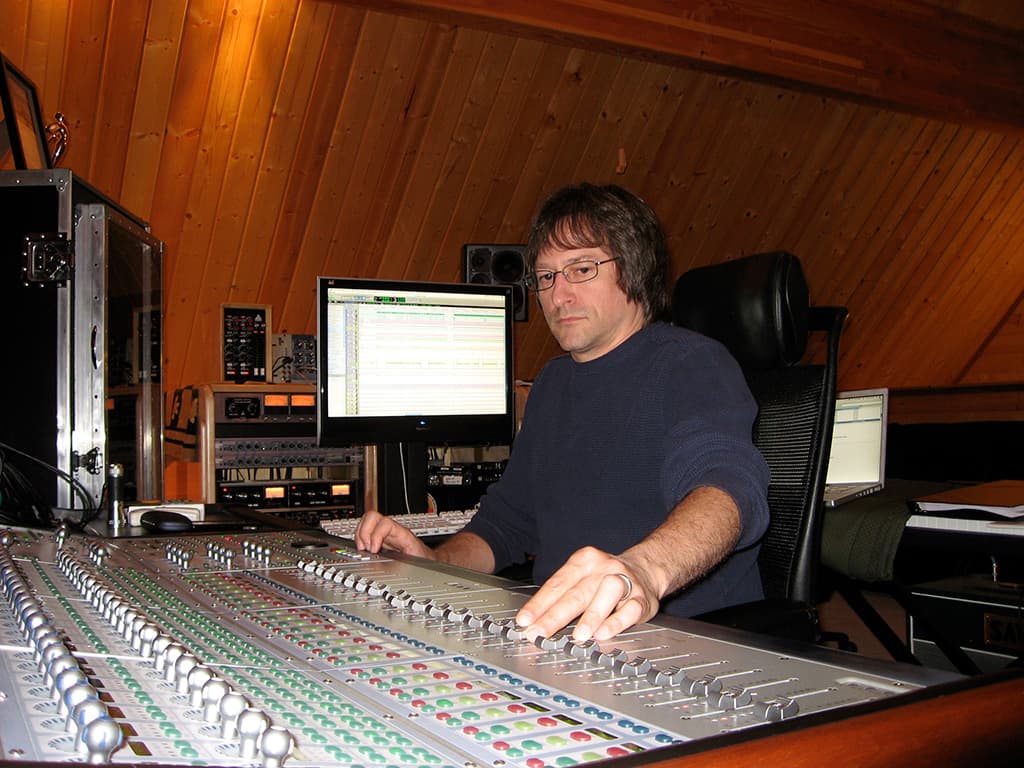

HARD COPY
With close to 300 Pearl Jam live albums under his belt during the last decade – many recorded and mixed in different ways – Eliason has quite a story to tell. During 2000 – 2002, a split from stage would go to a bus, where the then assistant engineer, John Burton, would record the show. Afterwards – often the same evening – Eliason would remix the show again on-the-fly, this time in the bus, and each show would be available soon afterwards on CD.
“Then, in 2003 I tried a little experiment,” Eliason continues. “I mixed the band in the truck, and sent stems over to another engineer sitting at FOH. It worked okay, but it wasn’t the same as sitting in the hall, and when I discussed it later with the band, they said: ‘we want you either at FOH or recording, not both.’ So I stuck with recording after that. I’d done FOH for 11 years, and was ready for a change. At that point I was using Grace Designs 801R remote controllable preamps as a front end on stage and the signal arrived at line-level at the analogue Midas XL4 console in the truck. The multitrack recordings were taken from the direct outs with only the EQ settings and dynamics; no effects or other treatments. I prefer to remix from scratch.
“Pearl Jam weren’t touring much during 2004, so that year I went on the road with R.E.M. That gig lasted until late 2005, at which point I went back out on another Pearl Jam tour, which carried over into 2006. By this time we’d set up the recording side of things in a 24-foot shipping container, which was always transported to wherever the band was touring.
“I was recording and mixing the show on a digital desk, the Digico D5. I had two racks under the stage – one for the Grace Design preamps and one for the Digico input – I took a split from the stage, and ran 1000 feet of fibre-optic cable to the container. I also had armoured Cat5 for a video display and preamp remote control, so I could see what was happening on stage. I then went MADI from the Digico to a Euphonix FC726 format converter, and from there, AES/EBU into the ProTools HD rig.
“By now we were digital the whole way down the line, and made the show available for download within hours of the show ending, as MP3 or FLAC files. The download situation was pretty cool, but the thing we bumped into was that these files were becoming collectibles, and people still wanted hard goods. So for that reason, later releases were also made available as CDs. After the 05/06 tour it was decided that the expense and logistics of having me, John, another tech, the container, the tractor pulling the container, and transport costs were becoming too much of a financial burden. So John Burton continued recording the concerts to ProTools multitrack, and I decided to stay at home and focus on my work here at my studio outside of Seattle. From that point onwards, John would ship me the drives by courier in as timely a manner as was possible, and I’d turn the mixes around as quickly as I could and upload them via broadband.”
FOLLOW THE TRAILMIX
Brett Eliason’s Trailmix Studio is a homely, wood-panelled space full of natural daylight, idyllically located in the middle of a mountain forest. The engineer recalls that he began his studio in 2000 in the basement of his house, much to his wife’s “chagrin”, who “for some reason or another didn’t enjoy the sound of endless soloing of bass drums reverberating around the house.” She must have been relieved in May 2007 when Eliason finally moved to the studio’s current location – 50 feet away from his house, above the garage. Throughout, Eliason has been proud to call Trailmix an analogue/digital hybrid. Until 2006 he was working on a Digidesign ProControl, and since then a D-Command. But while ProTools and a digital control surface are clearly at the heart of his studio, it’s also awash with several racks of analogue outboard, all of which was used in his mix of Live On Ten Legs. Eliason gives us the lowdown…
“My automation, bussing structure, sends and so on are all within the mix platform inside ProTools, but the majority of my EQ’ing, dynamic processing, and effects go on in the analogue domain, via the ProTools A/D and D/A converters. Digital converters and delay compensation engines have become much better over the years, so plugging analogue outboard into my digital system has become a lot easier. I don’t like using plug-ins too much – I have yet to bump into one that sounds anything like the analogue stuff. There’s an inherent phase distortion in the analogue circuitry that has a really wonderful effect. I have heard people do beautiful mixes entirely inside of DAWs, but in my opinion they still sound two-dimensional. It doesn’t mean that it can’t sound gorgeous, but there’s no air or depth. I’m very entrenched in what happens when you grab an API 550 or 560 EQ or a Neve 1073 or 1081, and so on.
“My studio is built as a mix suite, although I have recorded people’s vocals here. It has an A-frame roof and pine ceiling. When I had it constructed, I looked into formulas for angles and ceiling heights and square footage and all that, and got it as flat as I could, but also with an eye towards the aesthetics I wanted. And it turned out great. The ceiling in the old basement was only 7½ feet high, and I had to deaden it like crazy to get rid of the weird reflections. That worked pretty well, and I did many a great project in there, including in 5.1. But my current room sounds better. I have Adam S3A nearfields in front of me, M&K MPS2510Ps for surround, and the M&K MPS5310 sub. But 5.1 mixing is limited to sound for DVDs these days. The studio is remote, and I’m quite happy to mix on my own. People rarely come out here, other than to hang out. I have a high-speed broadband connection and am now sending full-quality CD cuts to people. The big advantage there is that clients can listen to them in environments that they’re used to, whether it’s their car or living room.”

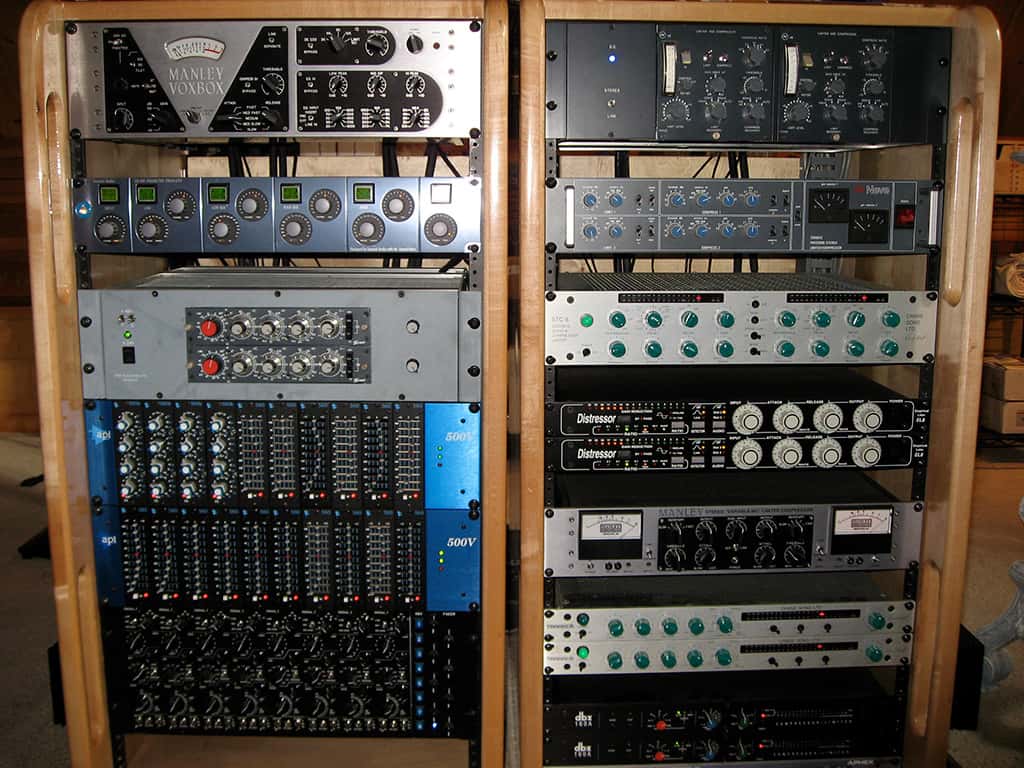
EXCITING LIVE CUTS
Eliason did all his mixes for Live On Ten Legs at Trailmix after an extended preparatory process. He explains: “Again, Live On Two Legs and Live On Ten Legs were considered companion albums, so we had the same approach on both – edit recordings from different concerts together to make it sound like one show. The recordings for Two Legs were all taken from (two US legs) in 1998, whereas the songs for Live On Ten Legs came from various different tours over eight years, recorded in different venues, cities and countries. The first step was to make a song selection. The band were looking for high-energy songs, and wanted these to represent each album era, while making sure some of the classics were included that didn’t make it onto Two Legs.
“So the band created a set list as a starting point, and then poor John [Burton] had to pull up the stereo mixes of the live recordings that we had of each song spanning 2003 – 10. Tim Bierman (head of Pearl Jam Ten Club), Christian Fresco (head of A&R for Pearl Jam’s record label, Monkeywrench), John and myself went through all of the versions we had of each song. So, for instance, if Jeremy was played 30 times over that eight-year period, we had 30 versions to listen to. To avoid going insane we split the songs between the four of us, and each one of us selected what we thought were the top two performances of each. We were looking for energy, groove, technical performance, vocal performance – all the things that make an exciting live cut. We also had in mind that we weren’t planning on doing any overdubs; I might fix a small clanger in a repetitive part in ProTools by moving something around, but that was all. After that we presented our selection to the band, to make sure they were happy with these versions as well.
“I’d already mixed some of the material for Live On Ten Legs ‘broadcast style’ for the Bootleg Series, which obviously meant pulling a concert up and going for it. I was doing an average of four shows a week at the time, so I had to churn these things out, and didn’t have two or three or four hours to mix each song. I simply had to make things sound decent, rough it in like it was a FOH mix, the only difference being that if I blew a cue, I could step back and fix it. That worked fine for the Bootleg Series, but it’s not an album approach. So once the versions of the songs for Live On Ten Legs were selected, I grabbed the original multitrack ProTools sessions for each song, and loaded them all up. I had 56 inputs on the list, which included all the instruments that weren’t played on every song. I began by picking one of the songs that had a little bit of everything on it: keyboards, Ed [Vedder] playing guitar, etc… things that didn’t happen in every song. There were multiple mics on many of the instruments, and initially I would decide on the blend I liked best, whether it was a kick drum, a snare drum, a keyboard or guitars.”
THE BIG MONSTER
Before dealing with his biggest challenge, which was to blend all the songs into a unified whole, Eliason mixed each song individually, making intense use of his analogue outboard. He explains, beginning with his treatment of the drums: “I have a rack of Helios Type 69 mic pre/EQ modules, which I used on the snare, toms, and overheads. Dynamics control was taken care of by my dbx 160VU and 160S compressors, and that was mostly it. I have a couple of Trident 80B modules that I used on the kick drum, and I also layered the kick for some more depth and snap. Matt Cameron is an amazing drummer, and I don’t replace his sounds completely, but because he’s playing the heck out of the same kit for two or three hours on stage, things can get tired and out of tune – there are temperature changes, and so on… all sorts of things that change the sound of the instruments for better or worse. Instead of adding a ton of 60Hz on a channel that’s also picking up the bass guitar, it’s more effective to add some extra drum sounds and mix them in.
“On the bass guitar I had the Rupert Neve-designed Summit EQP200A, which is a digitally-controlled analogue EQ that works great on bass. I combined that with the ELI Distressor for dynamic control. On guitars I used some Neve 1081 EQ, and more of the Helios Type 69 modules, but predominantly my go-to boxes are the API 560 10-band graphic EQ, and compressors like the Neve 2254a, Manley Vari Mu, and Crane Song STC-8. I choose any combination of those, depending on the song, the sound, the parts, and the instruments the band members are playing. For example, I like to run acoustics through the Vari Mu and sometimes the STC-8. I might put a Telecaster through a tube compressor, just to take some of the edginess off the top. On heavier parts I like to use the 2254 because it smoothes things out.
“On keyboards I will typically use the API 554 EQ, sometimes the API 560, along with the Neve 33609, which I like a lot. On the vocals I had my Shep SN8 modules – which are basically Neve 33115s – and a Crane Song Trakker, which is a single-channel compressor/limiter made by Dave Hill, who used to work for Summit – they’re really neat. That works really great on vocals, because you just start flipping models on the compressor, and you quickly find something that sits perfectly in your track. I will also set up some effects, like a Lexicon PCM60, AKG spring reverb, my EMT 240 plate, and so on, which I’ll blend in on various instruments.
“But the biggest challenge when mixing live recorded material remains the room itself. That’s the real monster you have to wrestle with. The way the PA reacts to the room has a huge influence on the audience microphones as well as with what’s happening on stage. If everybody on stage has in-ears, which is another big advancement in the monitor world, it helps to clean up the stage an awful lot. Audience microphone placement is a big thing too. Throwing them all over the hall doesn’t really work, because of timing delays and phasing issues. I tend to use six audience microphones: an Audio-Technica 8035 shotgun and Oktava MK012 condenser on the downstage stage left and right areas, with the condensers angled towards the centre of the floor for a more close-up sound, and the A-Ts aimed at the back corners, giving me more of the white noise crowd sound. I’ll also have a Shure VP88 stereo mic on a high stand close to the FOH desk. I can’t mix that signal in with the music because of time alignment and phase issues, but I use that to fill in the gaps between songs. It also gives me a beautiful back wall element when I’m mixing 5.1. When setting up a mix, I spend quite a lot of time sending these mics through an RTA (real time frequency analyser). I like to use the Klark Teknik DN6000, set in high, 1/6th -octave resolution, and digital EQ, which allows me to get very narrow notches going, and flatten out the peaks and valleys in the room as much as I can. I’ll then sum the audience mics to a stereo track, and run a two-channel limiter across them to control any big swells or peaks.”

COMMON THREAD
Moving onto the subject of creating the illusion that all songs came from one concert, Eliason explained that there were two aspects to this: one was to match up all the crowd noise, the other was to address any sonic inconsistencies within each of the songs. Eliason first elaborated on streamlining his mixes: “Over the eight years this album covers the guys had changed their rigs, their amps, their instruments, and so on, plus I was dealing with different room acoustics. But of course, you don’t want the guitars and other instruments to change too dramatically from track to track. So once I’d mixed a song or two, I was looking for a common thread, a common sonic quality that made the album sound like one show.
“As I progressed, I would sometimes go back to earlier mixes to touch something up. For this reason, and also to be able to incorporate feedback from the band, I made sure I could do a mix recall. After I’d completed a song mix, I bussed each audio track to a new track, internally (within ProTools), post fader and insert – i.e. with plug-ins and hardware outboard included. Trying to recall a 10-band graphic analogue EQ is impossible – a hair’s width can make all the difference! I also copied the effects sends over to the new tracks and then made the originals inactive. With the new faders set to 0dB, my mix plays back exactly as I completed it and from there it was very easy to do a volume ride here and there, which is what 99% of requests for changes are about. No recalling of outboard gear necessary, other than effects like reverb, because the sends follow the fader, and if I changed the volume it wouldn’t have the same dynamic structure. So I did charts of the effects I used and how they were set.
“After all the songs were mixed, I threw them into one session, and started conforming, crossfading and turning everything into one show. I would listen to bits of each song and made sure they blended and sounded like a cohesive set that could have come from one show. If not, I’d go back to the multitrack sessions and change a few things. With regards to the audience noise, I’d mixed each song with handles of audience noise in and out of the song. In some cases these were very short, in other cases I had a lot of audience to work with. If I had enough crowd noise in these handles, and if the dynamics were right, I would stretch and blend them together, but I also found a good segment of audience noise from one particular performance that had a really nice neutral sound and energy about it. I mixed that to stereo and blended it where necessary until it sounded natural. It’s a task that took a few hours, for sure. All the songs were finally mixed back into ProTools, and from there went to Ed Brooks at RFI/CD Mastering in Seattle for the finishing touch. Ed did a great job, and also did a separate vinyl version that’s not as dynamically controlled as the CD version; he allowed it to breathe a bit more.”
In unifying live and studio, digital and analogue, different live recordings into one concert, mixing and mastering, and a final album as download, CD and vinyl versions, it appears that Brett Eliason, contrary to Todd Rundgren’s assertion, has managed to make parallel lines meet.









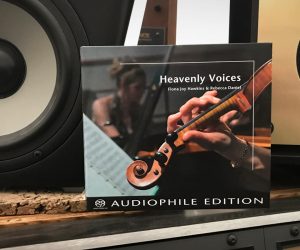

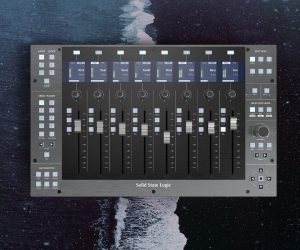




RESPONSES